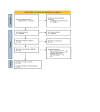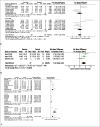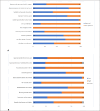The Effects of Physical Activity on Experimental Models of Vascular Dementia: A Systematic Review and Meta-Analysis
- PMID: 39156626
- PMCID: PMC11325693
- DOI: 10.1177/09727531231192759
The Effects of Physical Activity on Experimental Models of Vascular Dementia: A Systematic Review and Meta-Analysis
Abstract
Background: Physical activity is associated with improved brain health and cognition in humans. However, the validity, range, and quality of evidence for the beneficial outcomes linked to exercise in experimental models of vascular dementia (VaD) have not been evaluated. We performed a systematic review and meta-analysis of studies that assessed the effect of exercise intervention on models of VaD to provide an unbiased and comprehensive determination of the cognitive function and brain morphology benefits of exercise.
Summary: A systematic search in three databases as well as study design characteristics and experimental data extraction were completed in December 2021. We investigated the effects of exercise on cognitive function and brain-morphology outcomes in VaD models. Twenty-five studies were included for systematic review, while 21 studies were included in the meta-analysis. These studies included seven models of VaD in rats (60%, 15 studies), mice (36%, 9 studies), and pigs (4%, 1 study). None of the included studies used aged animals, and the majority of studies (80%) used only male animals.
Key message exercise improves cognition but increased neuro-inflammation in vad models: Exercise improved cognitive function as well as some markers of brain morphology in models of VaD. However, exercise increased anxiety and neuro-inflammatory signals in VaD models. Further, we observed increased reporting anomalies such as a lack of blinding to group treatment or data analysis and randomization of animals to groups. Our report could help in the appropriate design of experimental studies seeking to investigate the effects of exercise as a non-pharmacological intervention on VaD models with a high translational impact.
Keywords: Physical activity; cognitive function; meta-analysis; preclinical; systematic review; vascular dementia.
© The Author(s) 2023.
Conflict of interest statement
The authors declared no potential conflicts of interest with respect to the research, authorship, and/or publication of this article.
Figures










Similar articles
-
Behavioural modification interventions for medically unexplained symptoms in primary care: systematic reviews and economic evaluation.Health Technol Assess. 2020 Sep;24(46):1-490. doi: 10.3310/hta24460. Health Technol Assess. 2020. PMID: 32975190 Free PMC article.
-
Effectiveness of interventions that assist caregivers to support people with dementia living in the community: a systematic review.Int J Evid Based Healthc. 2008 Jun;6(2):137-72. doi: 10.1111/j.1744-1609.2008.00090.x. Int J Evid Based Healthc. 2008. PMID: 21631819
-
Effectiveness of interventions that assist caregivers to support people with dementia living in the community: a systematic review.JBI Libr Syst Rev. 2008;6(13):484-544. doi: 10.11124/01938924-200806130-00001. JBI Libr Syst Rev. 2008. PMID: 27820474
-
Efficacy and safety of Buyang Huanwu-Tang (Boyang Hwano-Tang) in patients with vascular dementia: A protocol of systematic review and meta analysis.Medicine (Baltimore). 2021 May 28;100(21):e25886. doi: 10.1097/MD.0000000000025886. Medicine (Baltimore). 2021. PMID: 34032701 Free PMC article.
-
Physical activity interventions for disease-related physical and mental health during and following treatment in people with non-advanced colorectal cancer.Cochrane Database Syst Rev. 2020 May 3;5(5):CD012864. doi: 10.1002/14651858.CD012864.pub2. Cochrane Database Syst Rev. 2020. PMID: 32361988 Free PMC article.
Cited by
-
Treadmill exercise pretreatment ameliorated structural synaptic plasticity impairments of medial prefrontal cortex in vascular dementia rat and improved recognition memory.Sci Rep. 2024 Mar 26;14(1):7116. doi: 10.1038/s41598-024-57080-4. Sci Rep. 2024. PMID: 38531892 Free PMC article.
References
-
- van Norden AG, van Dijk EJ, de Laat KF, et al.. Dementia: Alzheimer pathology and vascular factors: from mutually exclusive to interaction. Biochem Biophys Acta 2012; 1822: 340–349. - PubMed
-
- Richard E, Moll van Charante EP, and Van Gool W.. A Vascular risk factors as treatment target to prevent cognitive decline. J Alzheimers Dis 2012; 32(3): 733–740. - PubMed
-
- Aggarwal NT and Decarli C.. Vascular dementia: emerging trends. Semin Neurol 2007; 27: 66–77. - PubMed
Publication types
LinkOut - more resources
Full Text Sources

